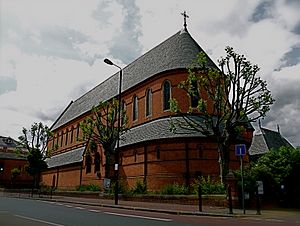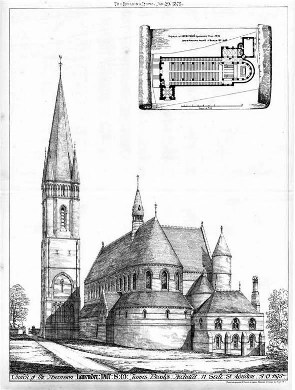The Ascension, Lavender Hill facts for kids
Quick facts for kids The Ascension of The Lord, Lavender Hill |
|
|---|---|

Exterior photo of The Ascension, Lavender Hill
|
|
| Country | United Kingdom |
| Denomination | Church of England |
| Website | Parish Website |
| History | |
| Dedicated | 1883 |
| Architecture | |
| Architect(s) | James Brooks |
| Administration | |
| Parish | Lavender Hill, The Ascension and Battersea, St. Philip with St. Bartholomew |
| Diocese | The Diocese of Southwark Formerly the Diocese of Rochester |
The Ascension of The Lord, Lavender Hill is a special Church of England church in Battersea, South West London. It follows the Anglo-Catholic tradition, which means its worship style is similar to Roman Catholic churches. This church is believed to be the first in England named after The Ascension of The Lord.
The church was designed by architect James Brooks. Its first stone was placed in 1874, and it was officially opened for worship in 1883.
The Ascension is one of three churches that make up the parish of Lavender Hill. The other two churches are no longer used by the Church of England. One is now an Ethiopian Orthodox church, and the other is a Greek Orthodox church.
This church should not be confused with another church called the Ascension of Our Lord in Balham, which is in the same area.
Contents
History of the Church
How the Church Started
The idea for The Ascension, Lavender Hill, came mostly from a priest named Fr John Bourdieu Wilkinson. When he was young, he often sat on Clapham Common and looked down at the fields of lavender that gave Lavender Hill its name. He dreamed that if he became a priest, he would build a church there.
Later, he became a priest and was sent to a church in Pimlico. At that time, there were protests against certain church practices. These events made Fr Wilkinson want to create a peaceful Anglo-Catholic church away from the busy Central London area.
Some wealthy ladies helped pay for the new church. They bought the land where the church now stands. In 1872, Father Wilkinson and these ladies moved to Lavender Hill, and the church building project began.
Building the Church
Many people living nearby, especially railway workers, wanted the new church to look like the churches they knew from East London. So, a famous Anglo-Catholic architect named James Brooks was chosen to design it. Many people think it became one of his best churches.
The first stone of the church was laid on June 1, 1874. It was placed under the altar of a temporary church that was being used.
Brooks soon found that building the church's foundations was costing too much money. Because of this unexpected expense, he was replaced by other architects, J. T. Micklewaite and Somers Clark. They finished the church almost exactly as Brooks had planned. However, because of the high costs, some of Brooks' more detailed designs could not be built. This included fancy stone carvings, a planned tower with a tall spire, and a detailed altar screen.
Like Brooks' other churches, The Ascension has a strong, simple design, built with bricks. It has a continuous roofline along the whole building. Light comes into the main part of the church (the nave) through tall, narrow windows high up. There are no windows in the side aisles.
The new church was officially opened for worship by the Bishop of Bishop of Rochester, Anthony Thorold, on June 30, 1883.
The Fire of 1979
Just before 7 PM on Friday, April 13, 1979, which was Good Friday, a big fire started. It quickly spread along the church roof and almost destroyed the entire building. The London Fire Brigade sent firefighters from six different stations. They worked all night to save this important landmark. The priest at the time, Fr John Cuthbert, praised the firefighters. He said that without their help, the damage would have been much worse.
Church Worship Style
The Ascension, Lavender Hill, is an Anglo-Catholic church. This means its services and practices are very similar to those in the Roman Catholic Church. The church focuses on the Seven Sacraments, which include Confession. Other practices include keeping the Blessed Sacrament, honoring Relics, Benediction of the Blessed Sacrament, saying the Rosary, showing devotion to Mary, and following the Stations of the Cross.
Sunday Mass at The Ascension includes "bells and smells." This means incense is used throughout the service, and bells are rung during the Eucharist (Holy Communion). There are also lay deacons and servers who help during the service. They wear traditional black robes (cassocks) and white over-robes (cottas).
Gallery
Parish Priests
| No. | Priest | From | Until |
|---|---|---|---|
| 1 | Fr John Bourdieu Wilkinson SSC | 1874 | 1885 |
| 2 | Fr Charles Stebbing Wallace SSC | 1885 | 1914 |
| 3 | Fr John Arthur Mainwaring Montford | 1914 | 1923 |
| 4 | Fr Egbert de Grey Lucas | 1923 | 1930 |
| 5 | Fr Donald Vincent Beckingham | 1930 | 1938 |
| 6 | Fr Herbert Edwin Palmer | 1939 | 1943 |
| 7 | Fr John Austin Allen SSC | 1944 | 1958 |
| 8 | Fr Edward Bruce Branwell | 1958 | 1964 |
| 9 | Fr Alan George Cookman SSC | 1965 | 1972 |
| 10 | Fr John Hamilton Cuthbert CMP | 1972 | 1997 |
| 11 | Fr Patrick Charles Benedict Allen OSB SSC | 1997 | 2008 |
| 12 | Fr Iain Clavering Young SSC | 2009 | 2021 |
| 13 | Fr Philip Kennedy SSC | 2021 | Present |




